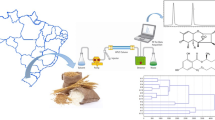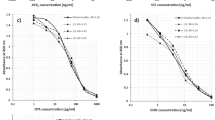Abstract
The interest in LC-MS/MS multi-mycotoxin methods unveiled an urgent need for multi-mycotoxin reference material. A multi-fusariotoxin, including deoxynivalenol (DON); zearalenone (ZEN); T-2 toxin (T-2); HT-2 toxin (HT-2); enniatin A, A1, B, and B1 (ENNs); and beauvericin (BEA), contaminated wheat flour was obtained by inoculation Fusarium spp. strains. The candidate material has successfully passed the homogeneity test and submitted to an international interlaboratory study achieved by 19 laboratories from 11 countries using their routine analytical method. The dispersion of the results for ZEN and BEA did not allow the derivation of reliable consensus values, while the assignment was only possible for DON, HT-2, T-2, and ENN A. No link was found between the methods used by the participants and the results. Significant changes in dry matter contents (≥±1.4 % of the initial dry matter) and significant changes in ergosterol contents (≥±10 %) did not occur. Using the mycotoxin contents in wheat flour stored at −80 °C as reference values, statistically significant decreases were observed only for T-2 contents at +24 °C, in contrast to the storage at −20 and +4 °C. For the other involved toxins, the candidate material was found to be stable at −20, +4, or +24 °C. Based on the T-2 decreases, a shelf life of 6 years was derived from isochronous study when the material is kept at −20 °C. At room temperature (e.g., +24 °C) or higher, this time validity drastically decreases down to 6 months. The development of this metrological tool is an important step towards food and feed quality control using multi-mycotoxin analyses. In vivo animal experiments using multi-mycotoxin-contaminated feeds dealing with the carryover or mitigation could further benefit from the methodology of this work.




Similar content being viewed by others
References
Beeton S, Bull AT (1989) Biotransformation and detoxification of T-2 toxin by soil and freshwater bacteria. Appl Environ Microbiol 55:190–197
Bremser W, Becker R, Kipphardt H, Lehnik-Habrink P, Panne U, Töpfer A (2006) Stability testing in an integrated scheme. Accred Qual Assur 11:489–495
CEN-TC (2003) Chemical analyses—determination of dry matter and water content on a mass basis in sediment, sludge, soil and waste—gravimetric method. TC WI:2003–2008 9p
EC (2002) Commission decision 2002/657/EC of 12 august 2002 implementing council directive 96/23/EC concerning the performance of analytical methods and the interpretation of results. Off J Eur Comm L221:8–36
EFSA (2014) EFSA scientific opinion on the risks to human and animal health related to the presence of beauvericin and enniatins in food and feed. EFSA Panel on Contaminants in the Food Chain (CONTAM) 2, EFSA J 12:3802; 174p
Emons H (2006) The ‘RM family’ identification of all of its members. Accred Qual Assur 10:690–691
Han Z, Tangni EK, Huybrechts B, Munaut F, Scauflaire J, Wu A, Callebaut A (2014) Screening survey of co-production of fusaric acid, fusarin C and fumonisins B1, B2, B3 by Fusarium strains grown in maize grains. Mycotoxin Res 30:231–240
Heydorn K (1998) The interpretation and use of stability data in the certification of reference materials. Accred Qual Assur 3:111–114
Jestoi M (2008) Emerging Fusarium-mycotoxins fusaproliferin, beauvericin, enniatins, and moniliformin—a review. Crit Rev Food Sci Nutr 48:21–49
Jestoi M, Kokkonen M, Uhlig S (2009) What about the ‘other’ Fusarium mycotoxins? World Mycotoxin J 2:181–192
Köppen R, Bremser W, Rasenko T, Koch M (2013) Development and certification of a reference material for Fusarium mycotoxins in wheat flour. Anal Bioanal Chem 405:4755–4763
Köppen R, Bremser W, Stephan I, Klein-Hartwig K, Rasenko TR, Koch M (2015) T2 and HT-2 toxins in oat flakes: development of a certified reference material. Anal Bioanal Chem 407:2991–3007
Krska R, Welzig E, Boudra H (2007) Analysis of Fusarium toxins in feed. Anim Feed Sci Tech 137:241–264
Liao CD, Wong JW, Zhang K, Hayward DG, Lee NS, Trucksess MW (2013) Multi-mycotoxin analysis of finished grain and nut products using high-performance liquid chromatography–triple-quadrupole mass spectrometry. J Agric Food Chem 61:4771–4782
Meng-Reiterer J, Varga E, Nathanail AV, Bueschl C, Rechthaler J, McCormick SP, Michlmayr H, Malachova A, Fruhmann P, Adam G, Berthiller F, Lemmens M, Schuhmacher R (2015) Tracing the metabolism of HT-2 toxin and T-2 toxin in barley by isotope-assisted untargeted screening and quantitative LC-HRMS analysis. Anal Bioanal Chem 407:8019–8033
Mol HG, Zomer P, García López M, Fussell RJ, Scholten J, de Kok A, Wolheim A, Anastassiades M, Lozano A, Fernandez Alba A (2015) Identification in residue analysis based on liquid chromatography with tandem mass spectrometry: experimental evidence to update performance criteria. Anal Chim Acta 873:1–13
Santini A, Meca G, Uhlig S, Ritieni A (2012) Fusaproliferin, beauvericin and enniatins: occurrence in food—a review. World Mycotoxin J 5:71–81
Serrano AB, Font G, Mañes J, Ferrer E (2013) Emerging Fusarium mycotoxins in organic and conventional pasta collected in Spain. Food Chem Toxicol 51:259–266
Solfrizzo M, De Girolamo A, Lattanzio VMT, Visconti A, Stroka J, Alldrick A, van Egmond HP (2013) Results of a proficiency test for multi-mycotoxin determination in maize by using methods based on LC-MS/MS. Qual Assur Saf Crops Foods 5:15–48
Sulyok M, Berthiller F, Krska R, Schuhmacher R (2006) Development and validation of a liquid chromatography/tandem mass spectrometric method for the determination of 39 mycotoxins in wheat and maize. Rapid Commun Mass Spectrom 20:2649–2659
Sulyok M, Krska R, Schuhmacher R (2007) A liquid chromatography/tandem mass spectrometric multi-mycotoxin method for the quantification of 87 analytes and its application to semi-quantitative screening of moldy food samples. Anal Bioanal Chem 389:1505–1523
Tang YY, Lin HY, Chen YC, Su WT, Wang SC, Chiueh LC, Shin YC (2013) Development of a quantitative multi-mycotoxin method in rice, maize, wheat and peanut using UPLC-MS/MS. Food Anal Methods 6:727–736
Tangni EK, Pussemier L (2006) Ochratoxin a and citrinin loads in stored wheat grains: impact of grain dust and possible prediction using ergosterol measurement. Food Addit Contam 23:181–189
Thompson M (2000) Recent trends in inter-laboratory precision at ppb and sub-ppb concentrations in relation to fitness for purpose criteria in proficiency testing. Analyst 125:385–386
Thompson M, Ellison SLR, Wood R (2006) The international harmonized protocol for the proficiency testing of analytical chemistry laboratories. IUPAC Techn Rep Pure Appl Chem 78:145–196
Van der Veen AMH, Nater DAG (1993) Sample preparation from bulk samples—an overview. Fuel Process Technol 36:1–7
Van Egmond HP, Schothorst RC, Jonker MA (2007) Regulations relating to mycotoxins in food. Anal. Bioanal Chem 389:147–157
Versilovskis A, Bernreuther A (2014) Certification of mass fractions of Fusarium mycotoxins deoxynivalenol and nivalenol in maize powder: ERM-BC717. Certification Report. EUR 26502 EN. doi:10.278/89217. Joint Research Centre - Institute for Reference Materials and Measurements. Geel (Belgium) 38p
Versilovskis A, Bernreuther A (2015) Progress in processing and certification of new mycotoxin matrix reference materials for mycotoxin analysis. ERM-BD285 (pistachios), ERM-BD286 (paprika powder) and ERM-BC473 (barley). doi:10.2787/394738. European Commission EUR 27431 EN - Joint Research Centre - Institute for Reference Materials and Measurements. 12p
Völkel I, Schröer-Merker E, Czerny CP (2011) The carry-over of mycotoxins in products of animal origin with special regard to its implications for the European food safety legislation. Food Nutr Sci 2:852–867
Warth B, Sulyok M, Krska R (2013) LC-MS/MS-based multibiomarker approaches for the assessment of human exposure to mycotoxins. Anal Bioanal Chem 405:5687–5695
Kluger B, Bueschl C, Lemmens M, Michlmayr H, Malachova A, Koutnik A, Maloku I, Berthiller F, Adam G, Krska R, Schuhmacher R (2015) Biotransformation of the mycotoxin deoxynivalenol in fusarium resistant and susceptible near isogenic wheat lines. PLoS One 10(3):e0119656
Nathanail AV, Varga E, Meng-Reiterer J, Bueschl C, Michlmayr H, Malachova A, Fruhmann P, Jestoi M, Peltonen K, Adam G, Lemmens M, Schuhmacher R, Berthiller F (2015) Metabolism of the Fusarium mycotoxins T-2 toxin and HT-2 toxin in wheat. J Agric Food Chem 63:7862–7872
Acknowledgments
We thank all the participating laboratories involved in the multi-mycotoxin interlaboratory study organized by CODA-CERVA in 2011.
Author information
Authors and Affiliations
Corresponding author
Ethics declarations
Conflict of interest
Authors declare that there is no conflict of interest for this manuscript.
Rights and permissions
About this article
Cite this article
Tangni, E.K., Debongnie, P., Huybrechts, B. et al. Towards the development of innovative multi-mycotoxin reference materials as promising metrological tool for emerging and regulated mycotoxin analyses. Mycotoxin Res 33, 15–24 (2017). https://doi.org/10.1007/s12550-016-0259-5
Received:
Revised:
Accepted:
Published:
Issue Date:
DOI: https://doi.org/10.1007/s12550-016-0259-5




